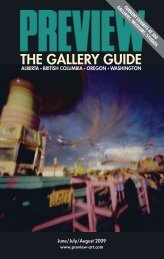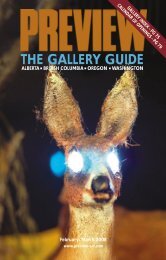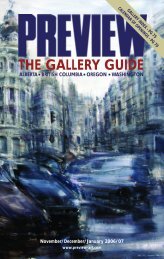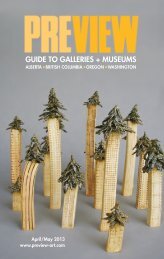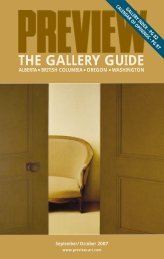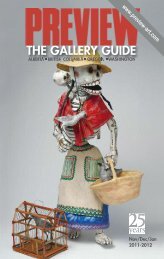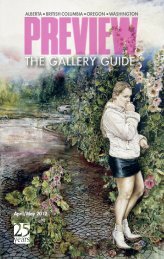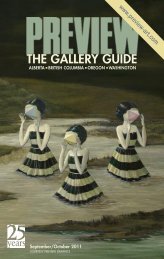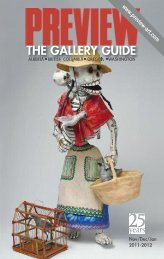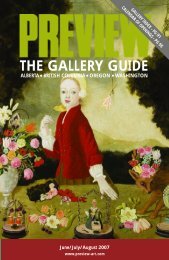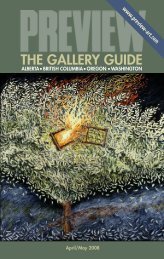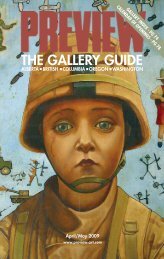Preview â The Gallery Guide â April-May 2007
Preview â The Gallery Guide â April-May 2007
Preview â The Gallery Guide â April-May 2007
Create successful ePaper yourself
Turn your PDF publications into a flip-book with our unique Google optimized e-Paper software.
BEHIND THE SCENES<br />
Inherent Vice<br />
This “Behind the Scenes” topic is not about the illicit<br />
proclivities of gallery personnel that are hidden from<br />
public view. No such luck.<br />
“Inherent vice”, however, is somewhat akin to the<br />
innate (bad and potentially self-destructive) behaviour<br />
triggered by the bit of DNA that impels a person to<br />
over-indulgence and, through excess, die prematurely.<br />
A similar flaw exists in certain artworks. Because of<br />
their inherent natures, such pieces will degrade over<br />
time or suffer from conditions (or other factors) in<br />
their surroundings that will diminish their effectiveness.<br />
Art depends on professionals: to detect their<br />
problems; to slow or stop the progress of their ‘maladies’<br />
and where possible, to endow them with eternal<br />
life.<br />
Conservator Monica Smith of the Vancouver Art<br />
<strong>Gallery</strong> is responsible for inspecting art objects. On<br />
Condition Report Forms there is a box beside the<br />
words “inherent vice”. If it is ticked, measures might be<br />
taken to stabilize (or ‘cure’) the piece before it is put on<br />
display or accepted into the collection.<br />
BY ANN ROSENBERG<br />
Ingrid and Iain Baxter, Bagged Landscape (1966),<br />
vinyl, 73 x 58 x 8 cm<br />
According to Rebecca Pavitt, another local expert in the field, inherent vice is a problem<br />
because, “Artists make art out of the darnest things.” Every gallery worker has one or more<br />
‘inherent vice’ story that they enjoy telling.<br />
My eyes popped out when I saw ants marching towards an animal fat sculpture at the Surrey<br />
Art <strong>Gallery</strong> to claim it as their prize. <strong>The</strong> insects were doing what nature compelled them to do in<br />
response to the ‘scent’ of the lard—an ingredient more fitting for a pie. A more horrifying invasion<br />
of picnic pests took place in Toronto’s Power Plant <strong>Gallery</strong> when two Mexican artists painted<br />
a mural using human fat as ‘paint’. According to Vancouver curator Keith Wallace, by the<br />
third day, the ‘goop’ was alive with ants and the smell was unbearable.<br />
Artists sometimes encourage, accept and even accelerate the deterioration of a piece by shining<br />
hot lights on the vegetation or bottom-of-the-food-chain creatures it includes. More typically,<br />
however, artists don’t want anything too detrimental to occur. This was undoubtedly the case<br />
with Liz Magor’s 1977 Time and Mrs. Tibor installation that the VAG exhibited just as the artist<br />
was gaining prominence.<br />
Time and Mrs. Tibor was an installation of Magor’s deceased neighbour’s wooden pantry that<br />
had been part of her tumbled-down farm house. On its shelves were Mrs. Tibor’s own preserves<br />
along with Magor’s newly canned jars of wild flowers. <strong>The</strong> sculpture was purchased by the<br />
National <strong>Gallery</strong> of Canada and shortly thereafter some substances in the jars began to ferment.<br />
Extraordinary measures were taken to eliminate the inherent vice so that Time and Mrs. Tibor<br />
could have an eternal, problem free-life.<br />
Many of the N.E.Thing Company’s ‘bagged’ vinyl landscapes, plastic inflatable abstract<br />
shapes, low-relief vacuum-formed or crushed container sculptures that were produced in the<br />
mid to late ‘60’s are not ageing well. This is due to the tendency of some plastics to bio-degrade,<br />
especially when exposed to heat and light. Some, but not these works, have become brittle and<br />
discoloured. Neither flaw can be reversed, but some pieces can be stabilized under certain conditions.<br />
In this case, it is up to fate and conservators to determine how long the works survive.<br />
COLLECTION OF THE VANCOUVER ART GALLERY, PHOTO: JIM JARDINE, VANCOUVER ART GALLERY<br />
22 PREVIEW




